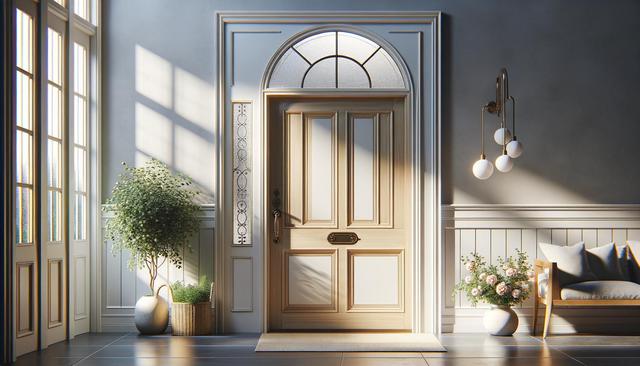Choosing the Right Material for Your Entry Door
When selecting an entry door, the material is one of the most important factors to consider. Different materials offer unique benefits in terms of durability, insulation, maintenance, and visual appeal. Common options include steel, fiberglass, and wood. Steel doors are known for their strength and security, making them a popular choice for homeowners focused on safety. Fiberglass doors, on the other hand, are highly resistant to wear and can mimic the look of wood without the upkeep. Wood doors offer unmatched warmth and character but may require more maintenance to protect against the elements. Understanding the characteristics of each material can help you make an informed decision that matches your priorities and lifestyle.
Each material has its own set of advantages:
- Steel: Excellent for security and energy efficiency.
- Fiberglass: Low maintenance and weather-resistant.
- Wood: Offers a timeless, natural look.
Ultimately, the right material depends on your climate, budget, and desired aesthetic. For example, in areas with high humidity or frequent storms, fiberglass may be the most practical option. If you’re aiming for a grand entrance with traditional charm, wood might be more suitable despite the extra care it requires.
Security Features That Matter
Security is a top concern for many homeowners when choosing a new front door. Fortunately, modern entry doors come equipped with various features that enhance protection. Multi-point locking systems, steel reinforcements, and impact-resistant cores are just a few of the innovations now available. These elements not only deter forced entry but also provide peace of mind. Additionally, the door frame and installation quality play a crucial role in overall security. A high-quality door installed in a weak frame may not offer the level of protection expected.
Some important security features to look for include:
- Heavy-duty deadbolts and strike plates
- Reinforced hinges and hinge bolts
- Smart lock compatibility for keyless entry
Investing in a secure entry door isn’t just about protecting belongings—it also safeguards your family and adds value to your property. Many homeowners find that a well-secured door reduces insurance premiums and increases resale appeal.
Energy Efficiency and Insulation
Beyond aesthetics and security, energy efficiency is a critical factor in choosing an entry door. A well-insulated door helps maintain indoor temperatures, reducing the strain on your heating and cooling systems. This not only lowers utility bills but also contributes to a more sustainable home environment. Doors with insulated cores, energy-efficient glazing, and tight weather seals can significantly reduce drafts and energy loss.
Features that enhance energy performance include:
- Foam-filled cores for thermal resistance
- Double or triple-pane glass inserts with low-E coatings
- Adjustable thresholds and weather stripping
When evaluating energy efficiency, look for doors that are ENERGY STAR® certified, as they meet strict guidelines set by regulatory agencies. These doors are tested for thermal performance and can be a valuable investment for long-term savings.
Style and Curb Appeal
An entry door is one of the first elements people notice about your home, making it a key part of your property’s curb appeal. The design, color, and hardware of your door can dramatically influence the overall look of your exterior. Whether you prefer a sleek, modern aesthetic or a more traditional appearance, there are countless styles to choose from. Many doors can be customized with decorative glass panels, sidelights, and transoms to add personality and natural light to your entryway.
Consider the following style elements when selecting your door:
- Panel configuration and door texture
- Glass options, such as frosted or stained glass
- Color finishes and hardware choices
Matching your door design with your home’s architecture enhances cohesion and visual interest. A well-chosen door not only reflects your personal taste but also boosts the perceived value of your home.
Maintenance and Longevity
Maintaining your entry door ensures it continues to perform well and look attractive over time. Different materials have different care requirements. Steel and fiberglass doors generally need minimal upkeep—typically just occasional cleaning and inspection for any signs of wear. Wood doors, while beautiful, require more frequent maintenance to protect against moisture, insects, and UV damage. This may include regular sealing, staining, or painting depending on exposure to the elements.
Practical maintenance tips include:
- Cleaning the surface with mild soap and water
- Inspecting weather stripping and hardware annually
- Reapplying finishes on wood doors as needed
Choosing a door with protective coatings or finishes can also extend its lifespan. Many modern doors are designed to resist warping, corrosion, and fading, making them a reliable long-term choice for homeowners who want both durability and minimal upkeep.
Conclusion: Finding the Right Entry Door for Your Home
Exploring front door options is about more than just picking a color or design. It involves balancing style, security, energy efficiency, and maintenance to find a solution that fits your home and lifestyle. Whether you prioritize protection, want to lower utility bills, or simply aim to enhance curb appeal, today’s entry doors offer a combination of features to meet a wide range of needs. By understanding the benefits of different materials and features, you can make a confident decision that adds long-term value and comfort to your home.




Leave a Reply